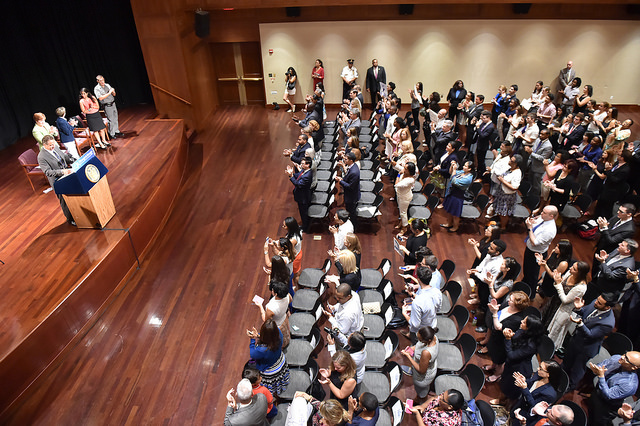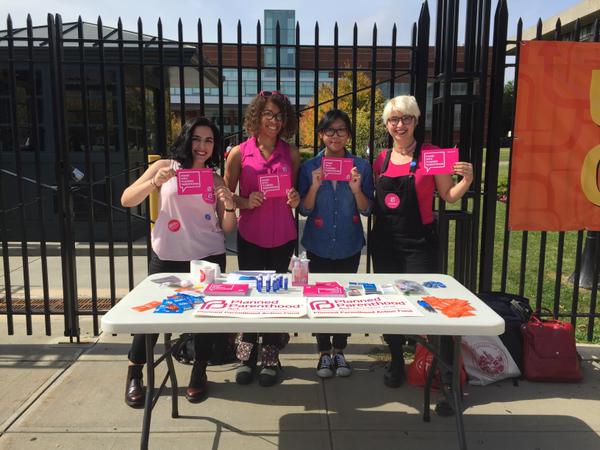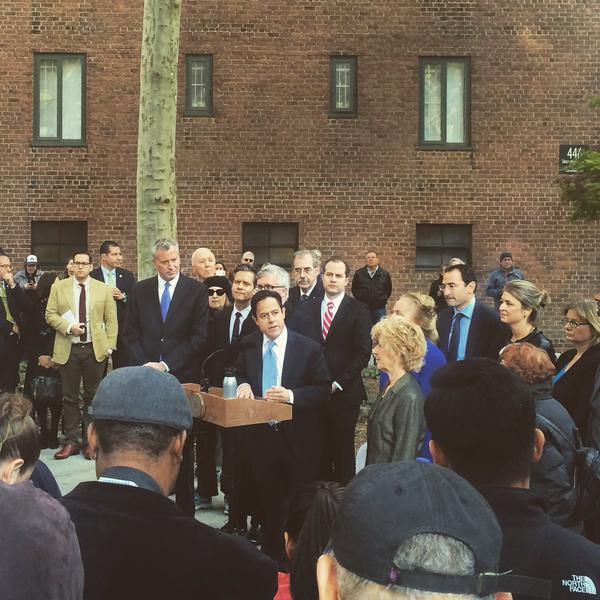New York Community Colleges Desperately Need Comprehensive Investment

Gov. Cuomo (Office of the Governor - Kevin P. Coughlin)
Governor Cuomo’s leaked plan to make community colleges in New York tuition-free, potentially aligning with President Obama’s America’s College Promise initiative, is an exciting step towards reinvesting in higher education after years of flat-lined funding and tuition hikes. This thinking, if it indeed means increasing our state’s investments in higher education, reflects an awakening around the role that community colleges play in the fabric of society and the future of our economy.
As it currently stands, insufficient state support for higher education in New York is failing students and families. Funding is down seven percent since the Great Recession, and a necessary “Maintenance of Effort” bill passed by the Senate and Assembly forcing the Governor to fund mandatory costs for SUNY and CUNY is on the Governor’s desk with an uncertain future.
What’s more, state support makes up only about a quarter of total community college revenue – leaving students to pay more in tuition, which is among the highest in the country. And at the same time that tuition at our community colleges has increased by $735 over the last 10 years, the Tuition Assistance Program (TAP) - our state’s need-based aid program, not available to part-time students - has only increased by $165 during that same time.
Indeed, increased investment by the state would mark a drastic and much-needed shift from burdening students and families with tuition hikes throughout the Great Recession, and a smart move that would renew our commitment to boosting the take home pay of hard-working New Yorkers.
Average earnings for full-time workers with an associate’s degree are nearly a third higher than earnings for those with only a high school diploma, not to mention that more educated people have additional opportunities to ascend the economic ladder.
But economic prosperity isn’t just good for the workers who are lucky enough to achieve it; it’s good for our state as a whole. It’s estimated that New Yorkers with an associate’s degree will contribute more than $35,000 in state taxes and a New Yorker with a bachelor’s degree will contribute more than $60,000 in state taxes throughout their lifetime. With 330,000 enrollees in the CUNY and SUNY community college system, that means an impressive return on investment.
The President’s initial vision for creating a federal free community college plan is understood to be a first-dollar contribution that pays tuition and fees up front, leaving any remaining federal Pell Grants to cover expenses like textbooks and other living expenses. For context, last year more than 160,000 New York State students received $160 million worth of federal Pell Grants, relying on both state and federal investments to cover not just tuition and other costs of attending school.
A state-federal partnership such as the one described by the Obama Administration (but that has stalled in Congress) could be crafted in a way that gives a federal match encouraging states to invest more and provide first-dollar support, making much-needed increased investment.
If a state pursues a free community college plan poorly, however, it could merely repackage its current investments to cover whatever tuition that the Pell grant (or any other future federal match) does not cover, or to make tuition free but reduce investments in critical need-based aid that help cover the full cost of going to school. That’s a direction that policymakers here should steer clear from.
As we head into the next legislative session in Albany, one thing is clear: we need to act quickly, and not point to the gridlock in Washington as a reason to throw up our hands, say we tried, but ultimately leave New Yorkers further behind.
Even with no additional matching federal dollars forthcoming anytime soon, the governor and other state policymakers can and should lead on this vision around committing new investments to community college students. Governor Cuomo can start with his upcoming executive budget proposal due in late January.
With the governor talking about an initial $500 million investment, and policymakers such as Assemblymember James Skoufis talking about a $2 billion “TuitionFreeNY” bill to provide free tuition to all SUNY and CUNY students, the time has come for New York State to put forward a comprehensive solution to address the needs of the state’s grossly under-resourced community college system and lead the country in creating a universally accessible public higher education opportunity.
In the early 1890s, the Committee of Ten, an elite group of academics and bureaucrats, found that four additional years (what we know as high school) of public education for every American student was necessary. It’s fitting that 125 years later we are having the same conversation to better fit our institutions to the needs of today’s workforce. The additional investment of $500 million, with or without federal matching dollars, is a step towards leading the way in what it means to value and leverage public education in the 21st century.
***
Kevin Stump is the Northeast Director for Young Invincibles (YI), an advocacy and policy organization working on higher education, health, and jobs issues impacting 18-34 year olds. YI is also a part of President Obama's College Promise Task Force. On Twitter @KevinStump and @YoungInvincible.
***
Have an op-ed idea or submission for Gotham Gazette? E-mail editor Ben Max: This email address is being protected from spambots. You need JavaScript enabled to view it.
In Schools and at Home, We Must Talk to Young People About Sex

PPNYC volunteers (photo: @PPNYCAction)
When I heard Salt-n-Pepa's song "Let's Talk About Sex" as a young person in the 1990s, it stirred my interest in the subject. I remember coming home and asking my mother about sex, and receiving responses that left me feeling frustrated.
I wasn't getting my questions answered in school either. Sex ed did not go into detail about body image or the emotional connection that came with experiencing sexuality. Unfortunately, in New York City many young people still aren't getting adequate information about sexual health or relationships at school. Like me two decades ago, many aren't getting this information from their parents or caregivers either. Today, young people are often left unequipped in a world filled with distorted sexual messages everywhere on social media, in advertisements, on TV, and elsewhere.
That's why it's so important that, as a city, we prioritize comprehensive, age-appropriate sex ed for all students, kindergarten through 12th grade.
It's also why, as a parent, I make a point to let my children know they can always come to me with questions about sex and sexuality, and I make sure they have accurate information and skills to make healthy decisions. I also joined Planned Parenthood of New York City's Adult Role Model team to educate other parents about how to talk to their kids about sex. Because so many parents are uncomfortable, the program helps provide them with guidance to start what should become an ongoing conversation.
My parents migrated to this country from the Caribbean, and in their culture, sex was not discussed in detail, especially with daughters. It was a brief topic of doom discussed when a girl began menstruating because then there was fear that she could end up pregnant. Girls were typically warned that if they had sex before marriage and became pregnant, the young man was likely to leave, which meant raising the child alone.
I was left on my own, with myths and misinformed answers from my friends, to figure out sexuality. Had my parents felt comfortable and had accurate information about sexuality, or had I learned much-needed information in the New York City school system, I believe my sexual experiences would have been filled with fewer heartbreaks and less gloom.
When I gave birth to my children, I vowed to educate and enlighten them on sexuality because I did not want them to go through similar experiences. When my daughter started middle school, I had questions about what exactly to tell her about sexuality. One day, she came home with a flyer for a workshop hosted by Planned Parenthood of New York City about sexuality and how parents could have these conversations with their children. I was elated - I went to the workshop eager and left equipped with the information and skills to talk more adequately with my children.
I learned that it was OK to give my children my values and that sexuality is more than just sex. I also learned how important it is for parents to have accurate information. In no way was I going to leave it up to the media, or my children's friends. Information about sex needs to come from me, I decided.
The next day I began educating my children, and put them at ease so they could come to me with questions. It was not just a one-time discussion or an accusatory one; it was from and full of love and respect for my children.
So then it began. I became their "go to" person for accurate messages and information about sex and sexuality. When my son was in middle school, he received a sex ed class. When the teacher described the reproductive systems, his peers were "oohing" and "ahhing." He said that he was so comfortable because he already received education about sexuality from his mom. In my head I was doing flips and shouting for joy.
Today, I go to various schools and communities, and I'm surprised that some parents are still not having these important conversations with their children. My children tell me stories about their friends and peers not having someone they can trust to talk to about sexuality.
So let's talk about sex—both in schools and at home. Who do you want your children to learn values from, if not from you? Would you want your child to engage in sexual activities with a partner out of fear or in ignorance? Would you want your child to engage in unprotected sex because they don't know any better?
It's heartbreaking that so many students still aren't learning these essential lessons at home or at school. We must prioritize sex ed in city schools, and encourage parents and the caring adults in the lives of youth to talk to young people about sexuality and sexual health early and often.
***
Marsha Blackman is an Adult Role Model with Planned Parenthood of New York City. Find Planned Parenthood on Twitter @PPNYCAction.
***
Have an op-ed idea or submission for Gotham Gazette? E-mail editor Ben Max: This email address is being protected from spambots. You need JavaScript enabled to view it.
The Future of Stuyvesant Town & Peter Cooper Village

CM Garodnick, the author, announcing the ST/PCV deal (photo: @DanGarodnick)
Major real estate transactions in New York too often create uncertainty for tenants living in previously stable communities. We all know what typically happens: the deal is done, the tenants are displaced, money is made. This is the story that has played out in Stuyvesant Town and Peter Cooper Village (ST/PCV) since 2006, when MetLife sold ST/PCV to Tishman Speyer for a record-setting $5.4 billion and many feared for the future of New York City's last big bastion of affordable housing for middle class New Yorkers.
These concerns only increased after the sale, as Tishman Speyer tried to make good on its investment by raising rents and eliminating as many affordable units as possible, converting them to market rate. Tishman Speyer was unsuccessful in its effort, and in 2010, defaulted on its significant debt. The fate of ST/PCV was left up in the air, and the tenants were left dreading that the story would end the way most would expect, with another unscrupulous landlord trying to force them out.
After years of hard work and advocacy, including winning a class action lawsuit at the Court of Appeals, fighting and reversing mid-lease rent increases, and getting Fannie Mae and Freddie Mac to stay away from any deal that did not have our blessing -- we have finally succeeded in getting the community on a more stable path.
Earlier this week, CWCapital announced its sale of ST/PCV to the Blackstone Group and Ivanhoé Cambridge, in an agreement that will be the largest city-led affordable housing preservation deal in history -- and one that can serve as a model for other parts of the City.
As part of the negotiations with the tenants and Mayor de Blasio, Blackstone has committed to preserving 5,000 rent-stabilized units for the next generation of middle-class residents. Under this deal, tenants who are currently in rent-stabilized units will be protected by rent-stabilization laws for as long as they reside in their apartment, and they are further protected by the City's agreement, which restricts the rent that can be charged on 5,000 units for the next 20-25 years, giving the new owner little incentive to turn over the units. And that timeframe could be extended down the line (as has happened many times in Stuyvesant Town and Peter Cooper since the early 1970s), with new agreements between the owners and the City or State.
Blackstone has also agreed to cap rent increases on about 1,400 tenants affected by the Roberts case, whose below-market-rate units could have been immediately brought to the market when the J-51 property tax abatement expires in 2020.
As a co-founder of the Coalition Against Predatory Equity in Housing, it was also critical to me that the structure of the deal was one that did not create pressure to evict rent-stabilized tenants based on the debt load. In 2006, the new owner had overleveraged the deal to a significant degree -- they had borrowed 80 percent of the purchase price, and the rents did not at all support the debt burden. That meant that they needed to quickly raise rents to pay their debt. In today's framework, the cash flow on day one will more than support the debt, creating very little pressure on Blackstone to make any sudden changes, or go after tenants.
That is why this deal has earned my support. When an active and organized body meets with the political will at all levels of government, important things can happen. And at a time when too many tenants are being left on the sidelines, we have struck a deal that will lead to a more stable community for tenants both old and new, and for the City.
***
Dan Garodnick is a member of the New York City Council representing the fourth district, in Manhattan, which includes Stuyvesant Town and Peter Cooper Village. Garodnick has served on the Council since 2006. He is on Twitter @DanGarodnick.
***
Have an op-ed idea or submission for Gotham Gazette? E-mail editor Ben Max: This email address is being protected from spambots. You need JavaScript enabled to view it.




